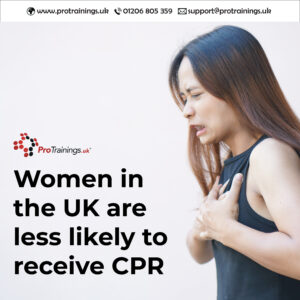 Cardiac Arrest: Addressing Gender Disparity in Bystander CPR for Improved Survival Rates
Cardiac Arrest: Addressing Gender Disparity in Bystander CPR for Improved Survival Rates
Cardiac arrest strikes suddenly, demanding immediate action to maximise survival chances. Bystander cardiopulmonary resuscitation (CPR) plays a vital role in saving lives during these emergencies. However, studies have revealed concerning gender disparities in bystander CPR provision, with women in the UK being less likely to receive CPR compared to men. This blog post examines the multifaceted factors contributing to this disparity and explores strategies to address the issue.
Understanding the Gender Disparity in Bystander CPR
Multiple research studies consistently highlight the gender disparity in bystander CPR. Societal norms, cultural biases, and anatomical and perceptual factors influence individuals’ responses during emergencies. Traditional gender roles and stereotypes inadvertently affect the decision to administer CPR. Unconscious bias stemming from the perception that women have a lower likelihood of experiencing cardiac arrest due to hormonal differences or less physical activity can impact bystanders’ actions. Fear and inadequate knowledge of CPR techniques may also contribute to hesitations in providing assistance, particularly to women.
Barriers and Challenges Faced by Bystanders
Some bystanders may be uncertain about the proper CPR technique, afraid of causing harm, or concerned about inappropriate contact due to societal perceptions. These uncertainties can hinder the prompt initiation of CPR, potentially worsening outcomes for female cardiac arrest victims. Additionally, anatomical differences between men and women play a role in the lower likelihood of bystander CPR for women. Women often exhibit different cardiac arrest symptoms than men, such as atypical chest pain or shortness of breath, which can be mistaken for other conditions. This misdiagnosis may lead to delayed recognition of the need for CPR or confusion among bystanders, further decreasing the likelihood of immediate action.
Addressing the Gender Disparity: Strategies for Change
Education and Awareness
To raise public awareness about the importance of CPR and dispel misconceptions about gender differences in cardiac arrest, educational campaigns are crucial. Emphasise that cardiac arrest emergencies can affect anyone, regardless of gender. Widespread CPR training programs should specifically address gender disparities, instilling confidence in bystanders to perform CPR on women. Training should focus on recognising cardiac arrest symptoms, understanding gender-specific variations, and overcoming potential psychological barriers. Utilise inclusive language and imagery in educational materials to counteract gender bias and encourage equal treatment in emergency situations.
Visual Representations
Highlight the significance of gender-neutral decision-making in administering lifesaving interventions through visual representations. Showcase women as both rescuers and recipients of CPR to reinforce the message that gender should not influence the decision to provide assistance.
Gender-Specific Considerations in CPR Guidelines
Healthcare authorities and professional organisations should integrate gender-specific considerations into CPR guidelines and protocols. These measures will guide bystanders and medical professionals, ensuring equitable care for cardiac arrest victims.
Closing the Gender Gap for Improved Cardiac Arrest Survival
Addressing societal bias, promoting education and awareness, and providing gender-inclusive training are crucial steps toward closing the gender gap in bystander CPR. By empowering bystanders to respond promptly and confidently, regardless of the gender of the individual in need, we can significantly improve cardiac arrest survival rates in the UK. Together, let’s create a society where every person, irrespective of their gender, receives the life-saving intervention they deserve during their most vulnerable moments.
Remember, gender should never hinder the delivery of timely CPR. Act now, save a life.
